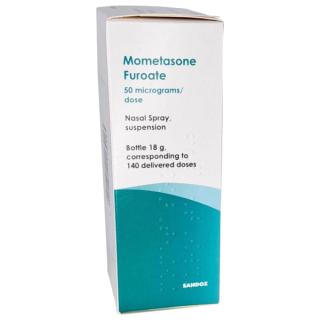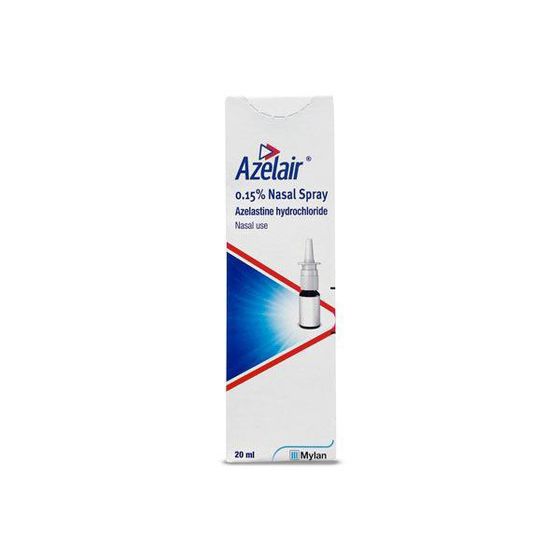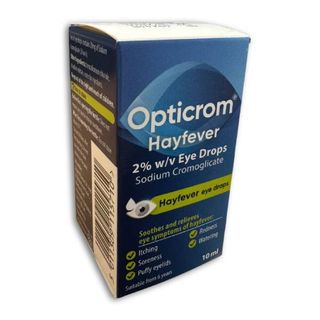

Azelair Nasal Spray
- Fast, discreet delivery
- 100% UK-based pharmacy
- Free advice and support
- We're rated 4.9 out of 5
Based on over 30,000 reviews collected on Google and Reviews.io.
We maintain the highest possible regulation for a UK online pharmacy, ensuring your experience is safe, and confidential.
Azelair is a prescription-only antihistamine nasal spray that alleviates common allergy irritating symptoms. It helps to ease congestion, prevent an itchy nose and relieve sneezing and a blocked nose.
Get your prescription of Azelair nasal spray online today from The Independent Pharmacy and get fast, affordable, hassle-free delivery from the comfort of your home.
Azelair summary information
Azelair Information
What is Azelair and what is it used for?
Azelastine is an antihistamine and mast cell stabilizer that is commonly used to treat allergy symptoms. Azelastine is effective in relieving symptoms associated with allergic rhinitis, including sneezing, runny or stuffy nose, itching, and nasal congestion. Azelastine works by blocking the effects of histamine, a substance produced by the body in response to allergens. By inhibiting histamine, Azelastine helps alleviate allergic symptoms.
What is the difference between Azelair and Rhinolast?
Azelair and Rhinolast both contain the antihistamine, azelastine. Azelair contains 0.15% azelastine, whereas Rhinolast contains 0.1% azelastine. This means that Azelair is 50% stronger than Rhinolast. For this reason, Azelair is only used once daily, rather than twice daily like Rhinolast.
What is allergic rhinitis?
Allergic rhinitis, commonly known as hay fever, is an allergic reaction that occurs when the immune system reacts to allergens in the air. The allergens can include pollen, dust mites, animal dander, and mold spores. When a person with allergic rhinitis comes into contact with these allergens, their immune system releases histamine and other chemicals, leading to various symptoms.
Common symptoms of allergic rhinitis include:
- Sneezing: Frequent and repeated sneezing is a common symptom.
- Runny or Stuffy Nose: The release of histamine can cause nasal congestion, leading to a runny or stuffy nose.
- Itchy or Watery Eyes: Allergic rhinitis often affects the eyes, causing itching, redness, and excessive tearing.
- Itchy Throat or Ears: Some individuals may experience itching in the throat or ears.
- Coughing: Postnasal drip caused by the excessive production of mucus may lead to coughing.
- Fatigue: Constant exposure to allergens and the body's immune response can cause fatigue and malaise.
How does Azelair work?
Nasal azelastine is an antihistamine, and it works by blocking the effects of histamine in the body. Histamine is a substance that the body releases during an allergic reaction. When someone is exposed to allergens such as pollen, pet dander, or dust mites, histamine is released, leading to common allergy symptoms such as sneezing, itching, runny nose, and nasal congestion.
Here's how nasal azelastine works:
- Histamine Blockade: Azelastine binds to histamine receptors, specifically the H1 receptors, on cells. By occupying these receptors, azelastine prevents histamine from binding to them.
- Reduction of Allergic Symptoms: Blocking histamine receptors helps to reduce the symptoms associated with histamine release. This includes decreased nasal congestion, sneezing, itching, and a runny nose.
- Anti-Inflammatory Effects: In addition to its antihistamine properties, azelastine also exhibits anti-inflammatory effects. This can help further reduce inflammation in the nasal passages.
- Mast Cell Stabilization: Azelastine can also stabilize mast cells, which are immune cells that play a role in allergic reactions. By stabilizing mast cells, azelastine helps prevent the release of additional histamine and other inflammatory substances.
How quickly does Azelair work?
The onset of action for nasal azelastine can vary from person to person, but many individuals may start to experience relief from allergy symptoms within 15 to 30 minutes after using the nasal spray. However, it's important to note that the full therapeutic effect may take a few days to be achieved with regular use.
Azelastine works by inhibiting the release of histamine, which is responsible for many allergic symptoms such as sneezing, itching, runny nose, and nasal congestion. Consistent and proper use of azelastine, as prescribed by a healthcare professional, is essential for obtaining optimal results.
Alternative Treatments to Azelair
There are several alternatives to nasal azelastine that are used for the treatment of allergic rhinitis (hay fever) or similar conditions. These alternatives may have different active ingredients but are generally intended to provide relief from common allergy symptoms. Here are some common alternatives:
- Oral Antihistamines:
- Cetirizine (Zyrtec): A non-sedating antihistamine.
- Loratadine (Claritin): Another non-sedating antihistamine.
- Fexofenadine (Telfast): Non-sedating and generally well-tolerated.
- Nasal Corticosteroids:
- Fluticasone (Avamys): A corticosteroid nasal spray that helps reduce inflammation.
- Budesonide (Rhinocort): Another corticosteroid nasal spray.
- Oral Decongestants:
- Pseudoephedrine (Sudafed): A decongestant that can relieve nasal congestion.
Azelair dosage
Adults aged 18 years and over should use two sprays in each nostril once daily. You can increase, if necessary, up to two sprays into each nostril twice daily.
How to use Azelair
Using nasal azelastine properly is essential to ensure its effectiveness and minimize the risk of side effects. Here are general instructions on how to use nasal azelastine:
- Read the Instructions: Carefully read the patient information leaflet provided by the pharmacist or included with the medication. Follow the instructions provided by your healthcare provider.
- Prepare the Nasal Spray: Shake the nasal spray bottle gently before use to ensure that the medication is well-mixed.
- Blow Your Nose: Before using the nasal spray, blow your nose gently to clear the nasal passages.
- Prime the Pump: If you are using the nasal spray for the first time or if you haven't used it for a few days, you may need to prime the pump. This typically involves spraying the medication into the air away from your face until you see a fine mist.
- Position Your Head: Tilt your head slightly forward. Keep your head in a neutral position, not tilted back.
- Insert the Nozzle: Gently insert the nozzle of the nasal spray into one nostril, aiming the spray toward the back and outer side of your nostril. Close the other nostril with your finger.
- Administer the Spray: Press down on the pump to release the spray while breathing in gently through your nose. Do not inhale the medication deeply; a normal breath is sufficient.
- Repeat for the Other Nostril: If your healthcare provider has instructed you to use the spray in both nostrils, repeat the process for the other nostril.
- Avoid Sniffing or Blowing Your Nose: Try to avoid sniffing or blowing your nose immediately after using the nasal spray to allow the medication to be absorbed.
- Clean the Nozzle: After use, wipe the nozzle with a clean tissue and replace the cap.
- Follow Dosage Instructions: Use the medication exactly as prescribed by your healthcare provider. Do not exceed the recommended dosage.
If you have any questions or concerns about how to use nasal azelastine, it's crucial to consult with your healthcare provider or pharmacist. They can provide personalised instructions based on your specific condition and needs.
Azelair ingredients
The active ingredient in Rhinolast Nasal Spray is: Azelastine hydrochloride 0.15% w/v.
The other ingredients are: Hypromellose, sucralose (E 955), liquid sorbitol (crystallising), disodium edetate, sodium citrate, and purified water.
Azelair side effects
Nasal azelastine, like any medication, may cause side effects in some individuals. It's important to be aware of potential side effects and contact your healthcare provider if you experience any unusual or severe symptoms. Common side effects of nasal azelastine may include:
- Nasal Irritation: Some people may experience mild irritation or a burning sensation in the nose.
- Bitter Taste: Azelastine can cause a temporary bitter taste in the mouth after use.
- Headache: Headaches are a possible side effect but are generally mild.
- Nausea: Some individuals may experience nausea, although this is not very common.
- Nosebleeds: Nasal irritation can occasionally lead to nosebleeds.
- Fatigue: Feeling tired or fatigued may occur in some users.
- Somnolence (Drowsiness): While this is less common with nasal azelastine compared to oral antihistamines, some individuals may experience drowsiness.
- Dry Mouth or Throat: Dryness of the mouth or throat can occur in some users.
Azelair warnings
While nasal azelastine is generally considered safe and effective when used as directed, there are certain warnings and precautions that individuals should be aware of before using this medication. It's important to consult with your healthcare provider and carefully follow their guidance. Here are some common warnings associated with nasal azelastine:
- Allergies and Sensitivities: Inform your healthcare provider if you are allergic to azelastine or any other medications. Additionally, disclose any known allergies to foods, preservatives, or dyes.
- Medical Conditions: Inform your healthcare provider about any pre-existing medical conditions, especially if you have a history of nasal sores, nasal surgery, or any nasal injury.
- Medication Interactions: Provide a list of all prescription and over-the-counter medications, vitamins, and supplements you are currently taking. Certain medications may interact with nasal azelastine, and your healthcare provider can assess potential interactions.
- Eye Conditions: If you experience eye problems or changes in vision while using nasal azelastine, contact your healthcare provider. While rare, there have been reports of eye-related side effects.
- Systemic Effects: Nasal azelastine is generally associated with low systemic absorption. However, if you experience symptoms such as excessive fatigue, muscle weakness, or irregular heartbeat, contact your healthcare provider.
- Driving and Operating Machinery: Nasal azelastine may cause drowsiness in some individuals. If you experience drowsiness, avoid driving or operating machinery until you know how the medication affects you.
Always follow the prescribed dosage and administration instructions provided by your healthcare provider. If you have any concerns or questions about the use of nasal azelastine, discuss them with your healthcare professional.
Azelair pregnancy and breastfeeding
If you are pregnant or breastfeeding, it is crucial to consult with your healthcare provider before using any medications, including nasal azelastine. While azelastine is generally considered safe for use during pregnancy and breastfeeding, it's essential to weigh the potential benefits against potential risks and consider individual circumstances.
Related Treatments
Visit our Hay Fever page for treatments, advice and FAQs.
Ordering as easy as 1, 2, 3
1. Find the ideal treatment
2. Get a free consultation
3. Enjoy speedy delivery


